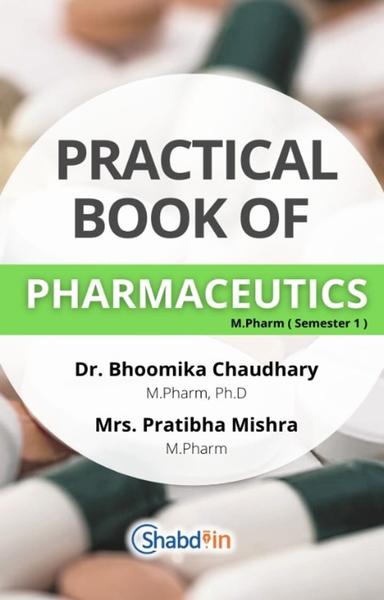AIM: To study the effect of particle size on dissolution of drug (give sample)
REFERENCES:
Kurtagi harun, memicmustafa, International Journal of Pharmacy and Pharmaceutical Sciences 29April, 2013.
REQUIREMENTS:-
1) Apparatus: - Beaker, Stirrer
2) Chemicals: -Drug, starch as disintegrate, starch as binder, Mg. Stearate, Talc Lactose, Potassium dihydrogen phosphate, Water, etc.
THEORY:-
Drug absorption from solid dosage form after oral administration depends on the release of the drug substance from the drug product, the dissolution or solubilization of the drug under physiological conditions, and the permeability across the gastrointestinal tract. Many drugs are poorly soluble, and this results in poor bioavailability because solubility is an important factor in determining the rate and extent of their absorption.
In vitro dissolution is often applied to predict in vivo drug performance especially in cases of poorly soluble drugs and extended release formulations. Formulation parameters have been identified as one of the factors that influences tablet characteristics. In give experiment study that variations in the manufacturing processes could consistently alter the disintegration, dissolution and consequently the bioavailability of the active ingredients in a product. However, it has also been shown that through physical modifications, the surface area, solubility and wettability of the powder particles can be increased thereby improving dissolution and hence bioavailability of poorly soluble drugs . The incorporation of adjuvant (like diluents, lubricants and surfactants) into tablet formulations can cause significant effects on the dissolution rate of drugs especially those that are hydrophobic and poorly soluble. Therefore the choice of formulation additives is often of critical importance in establishing a successful product for oral administration.
Why measure particle size of pharmaceuticals?
Particle size can affect – “Process ability” of powder (API or excipient) Flow, mixing, compaction, Final formulation: performance, appearance, stability
Methods for determination of particle size:
MicroscopySievingSedimentation techniquesOptical and electrical sensing zone methodLaser light scattering techniques[Surface area measurement techniques]1. Microscopy
The range Optical microscopy (1μm - mm) and the Electron microscopy (0.001μ-) Being able to examine each particle individually has led to microscopy being considered as an absolute measurement of particle size. It can distinguish aggregates from single particles and coupled to image analysis computers, each field can be examined, and a distribution obtained.
2. Sieving
Sieve analysis is performed using a nest or stack of sieves where each lower sieve has a smaller aperture size than that of the sieve above it. Sieves can be referred to either by their aperture size, mesh size or sieve number (BP, PhEur). According USP the mesh size is the number of wires per linear inch as 250 μm = No.60 and 125 μm = No. 120. Approx. size range: 5μm -3mm – Standard woven wire sieves. Electroformed micromesh sieves at the lower end or range (< 20μm. Sieving may be performed wet or dry, by machine or by hand, for a fixed time or until powder passes through the sieve at a constant low rate. In Machines used Shaking, Vibration, Use a jet of air to clear the sieves in Ultrasonic’s (wet sieving).
3. Sedimentation Techniques
Particle size range is (>1μm). These methods depend on the fact that the terminal velocity of a particle in a fluid increases with size. The particle size distribution of fine powder can be determined by examining a sedimenting suspension of the powder. There are two method of sedimentation techniques is as
a) The pipette method: e.g. the Andreasen pipette.
b) Photo sedimentation technique (Photo extinction sediment meters) : white light
Electrical Sensing Zone Method of particle size distribution determination
(Coulter Counter)
This instrument measures particle volume which can be expressed as d v : the diameter of a sphere that has the same volume as the particle. • The number and size of particles suspended in an electrolyte is determined by causing them to pass through an orifice an either side of which is immersed an electrode. • The changes in electric impedance (resistance) as particles pass through the orifice generate voltage pulses whose amplitude
is proportional to the volumes of the particles.
Light Scattering Techniques
(a) Laser Diffraction Particle Size Analysis (Particle size range 0.02-2000μm/0.01-3500 μm) Particles pass through a laser beam and the light scattered by them is collected over a range of angles in the forward direction. The angles of diffraction are, in the simplest case inversely related to the particle size.
(b) Photon Correlation Spectroscopy (Particle size range: 1nm to 5μm)
FORMULATION TABLE:-
cali | Ingredients | Quantity Given (I1) For 1Tab. | Quantity Given (I2) For 1Tab. | Quantity Taken(I1) For 10 Tab. | Quantity Taken(I2) For 10 Tab. |
1. | Drug | 100 | 100 | | |
2. | Starch as disintegrate | 10 | 10 | | |
3. | Starch as Binder | 5 | 5 | | |
4. | Mg. Stearate | 1 | 1 | | |
5. | Talc | 1 | 1 | | |
6. | Lactose | Q.S | Q.S | | |
| Total | 150mg | 150mg | | |
PROCEDURE:
Calibration of given drug
Before doing calibration of drug search standard official monograph of given drug because different drug having different monograph. By using the suitable pH medium prepare the stock solution. Check the absorbance at λ max at specified wavelength. Prepared the concentration in multiple of 2 μg/ml (Range 2, 4….10 μg/ml) and their UV Spectrophotometer absorbance was taken and prepared the standard curve.
Method for separation of particle size:-
1. Separation of particle by sieving method. Take 5g of give drug powder
2. Take half quantity of given powder first half portion of powder passed through the sieve No.USP 52.and retained on sieve No.USP 85.And name of this sample as I1.
3. Other half portion of powder passed through sieve No.USP 120 and separate out the powdered drug. Name of this sample as I2.
Preparation of tablet
1. The both preparations tablet were prepared by direct compression method.
2. The required quantity of drug and all excipients were weighed accurately
3. Mix the contents uniformly in a mortar pestle.
4. After mixing, pour the contents in hopper for punching of tablets.
5. Carry out the dissolution test to determine the change in dissolution of tablet due to
Change in particle size of drug in two different preparations.
RESULT:-
Remark:
Practical Performance (2) | Conduct in Lab (2) | Journal (2) | Observations and Results (2) | Viva-Voce (2) | Total (10) | Signature of Faculty In charge |
| | | | | | |
null






